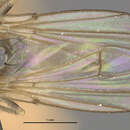Comprehensive Description
(
الإنجليزية
)
المقدمة من Smithsonian Contributions to Zoology
Notiphila (Notiphila) bella Loew
Notiphila bella Loew, 1862:135.
Notiphila (Notiphila) nudipes Cresson [in part], 1917:43.
Notiphila (Notiphila) bella Cresson, 1946:234.
TYPE-MATERIAL.—Lectotype male (herein designated): “Mittel St. (green)/Loew Coll./bella /Type 11134/Notiphila bella Lw, det W. Wirth ’61/LECTOTYPE Notiphila bella Loew by W. N. Mathis (red).” The lectotype is in the Museum of Comparative Zoology, Harvard University, type number 11134. Loew's original description indicated that both male(s) and female(s) were in the type series, and on a visit to the M.C.Z. I did locate a male and female specimen of N. bella with Loew's locality data. Both specimens also bear the paratype labels “M.C.Z. Paratype 11134,” and are herein designated as paralectotypes.
DIAGNOSIS.—Although specimens of N. bella very closely resemble those of other species belonging to the adusta group, they may be distinguished from them as follows: Antenna mostly black but extreme base of third segment may be pale, yellowish; fifth abdominal tergum considerably wider than long; genitalia of N. bella males most similar to those of N. taenia, but differing in the shape of the basiphallus, hypandrial process, and ventral process of epandrium. These differences are readily seen in Figures 13–15.
DESCRIPTION.—Medium-sized shore flies, length 3.03 to 3.64 mm, with bluish gray to brownish gray background coloration and few brown markings.
Head: Head ratio 1:0.78; postfrons ratio 1:0.89; frons subdued in coloration, mostly gray, median triangular area and lateral margins generally concolorous, remaining area of frons darker, slightly charcoal colored. Paravertical bristles small, approximately half the length of the genal bristle. No proclinate, fronto-orbital setae evident. Antennal segments mostly dark, black, although the base of the third segment slightly paler, orange; arista with 7–8 dorsal branches. Face very lightly colored, almost cinereous and nearly concolorous with frons; prefrons ratio 1:0.72; facial setae small, hairlike, only on ventral half of face. Eye ratio 1:0.81, eye-to-cheek ratio 1:0.26. Gena unicolorous, slightly darker in shade than face; genal bristle located posteriorly, size approximately double that of paravertical bristle. Maxillary palpus pale, yellow.
Thorax: Mesonotum brownish gray, darker than pleural areas; lateral margin with a brown stripe extending from anterior to presutural bristle to supra-alar bristle. Lateral margin of scutellum dark, blackish brown when viewed from posteroblique angle. Mesonotum with prominent brown stripe along dorsal margin. Femora gray, pale apically; tibiae and tarsi pale, yellow. Setal fascicle of hind basitarsus pale, yellow. Wing ratio 1:0.39; costal vein ratio 1:0.46; M1+2 vein ratio 1:0.96.
Abdomen: Abdomen ratio of males 1:77; length of fourth tergum to fifth tergum ratio of male 1:1; fifth tergum ratio of male 1:0.46. Fascia of the terga usually well defined, trigonal, sometimes reduced to a few spots. Male terminalia as in diagnosis and Figures 13–15.
SPECIMENS EXAMINED.—One specimen with the following label data: Osten Sacken Coll. (ANSP).
GEOGRAPHIC DISTRIBUTION.—Middle states.
- الاقتباس الببليوغرافي
- Mathis, Wayne Neilsen. 1979. "Studies of Notiphilinae (Diptera: Ephydridae), I: Revision of the Neartic Species of Notiphila Fallen, Excluding the Caudata Group." Smithsonian Contributions to Zoology. 1-111. https://doi.org/10.5479/si.00810282.287

